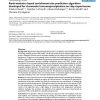Free Online Productivity Tools
i2Speak
i2Symbol
i2OCR
iTex2Img
iWeb2Print
iWeb2Shot
i2Type
iPdf2Split
iPdf2Merge
i2Bopomofo
i2Arabic
i2Style
i2Image
i2PDF
iLatex2Rtf
Sci2ools
BMCBI
2006
2006
Rank-statistics based enrichment-site prediction algorithm developed for chromatin immunoprecipitation on chip experiments
Background: High density oligonucleotide tiling arrays are an effective and powerful platform for conducting unbiased genome-wide studies. The ab initio probe selection method employed in tiling arrays is unbiased, and thus ensures consistent sampling across coding and non-coding regions of the genome. Tiling arrays are increasingly used in chromatin immunoprecipitation (IP) experiments (ChIP on chip). ChIP on chip facilitates the generation of genome-wide maps of in-vivo interactions between DNA-associated proteins including transcription factors and DNA. Analysis of the hybridization of an immunoprecipitated sample to a tiling array facilitates the identification of ChIPenriched segments of the genome. These enriched segments are putative targets of antibody assayable regulatory elements. The enrichment response is not ubiquitous across the genome. Typically 5 to 10% of tiled probes manifest some significant enrichment. Depending upon the factor being studied, this response can drop...
| Added | 10 Dec 2010 |
| Updated | 10 Dec 2010 |
| Type | Journal |
| Year | 2006 |
| Where | BMCBI |
| Authors | Srinka Ghosh, Heather A. Hirsch, Edward A. Sekinger, Kevin Struhl, Thomas R. Gingeras |
Comments (0)

